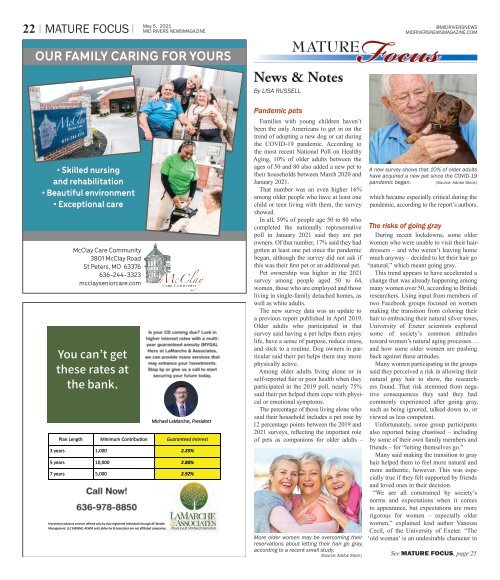Mid Rivers Newsmagazine 5-5-21
Local news, local politics and community events for St. Charles County Missouri.
Local news, local politics and community events for St. Charles County Missouri.
Create successful ePaper yourself
Turn your PDF publications into a flip-book with our unique Google optimized e-Paper software.
22 I MATURE FOCUS I<br />
May 5, 20<strong>21</strong><br />
MID RIVERS NEWSMAGAZINE<br />
@MIDRIVERSNEWS<br />
MIDRIVERSNEWSMAGAZINE.COM<br />
OUR FAMILY CARING FOR YOURS<br />
• Skilled nursing<br />
and rehabilitation<br />
• Beautiful environment<br />
• Exceptional care<br />
McClay Care Community<br />
3801 McClay Road<br />
St Peters, MO 63376<br />
636-244-3323<br />
mcclayseniorcare.com<br />
You can’t get<br />
these rates at<br />
the bank.<br />
Michael LaMarche, President<br />
Plan Length Minimum Contribution Guaranteed Interest<br />
3 years 1,000 2.25%<br />
5 years 10,000 2.80%<br />
7 years 5,000 2.92%<br />
Investment advisory services offered only by duly registered individuals through AE Wealth<br />
Management, LLC (AEWM). AEWM and LaMarche & Associates are not affiliated companies.<br />
News & Notes<br />
By LISA RUSSELL<br />
Pandemic pets<br />
Families with young children haven’t<br />
been the only Americans to get in on the<br />
trend of adopting a new dog or cat during<br />
the COVID-19 pandemic. According to<br />
the most recent National Poll on Healthy<br />
Aging, 10% of older adults between the<br />
ages of 50 and 80 also added a new pet to<br />
their households between March 2020 and<br />
January 20<strong>21</strong>.<br />
That number was an even higher 16%<br />
among older people who have at least one<br />
child or teen living with them, the survey<br />
showed.<br />
In all, 59% of people age 50 to 80 who<br />
completed the nationally representative<br />
poll in January 20<strong>21</strong> said they are pet<br />
owners. Of that number, 17% said they had<br />
gotten at least one pet since the pandemic<br />
began, although the survey did not ask if<br />
this was their first pet or an additional pet.<br />
Pet ownership was higher in the 20<strong>21</strong><br />
survey among people aged 50 to 64,<br />
women, those who are employed and those<br />
living in single-family detached homes, as<br />
well as white adults.<br />
The new survey data was an update to<br />
a previous report published in April 2019.<br />
Older adults who participated in that<br />
survey said having a pet helps them enjoy<br />
life, have a sense of purpose, reduce stress,<br />
and stick to a routine. Dog owners in particular<br />
said their pet helps them stay more<br />
physically active.<br />
Among older adults living alone or in<br />
self-reported fair or poor health when they<br />
participated in the 2019 poll, nearly 75%<br />
said their pet helped them cope with physical<br />
or emotional symptoms.<br />
The percentage of those living alone who<br />
said their household includes a pet rose by<br />
12 percentage points between the 2019 and<br />
20<strong>21</strong> surveys, reflecting the important role<br />
of pets as companions for older adults –<br />
More older women may be overcoming their<br />
reservations about letting their hair go gray,<br />
according to a recent small study.<br />
A new survey shows that 10% of older adults<br />
have acquired a new pet since the COVID-19<br />
pandemic began.<br />
(Source: Adobe Stock)<br />
which became especially critical during the<br />
pandemic, according to the report’s authors.<br />
The risks of going gray<br />
During recent lockdowns, some older<br />
women who were unable to visit their hairdressers<br />
– and who weren’t leaving home<br />
much anyway – decided to let their hair go<br />
“natural,” which meant going gray.<br />
This trend appears to have accelerated a<br />
change that was already happening among<br />
many women over 50, according to British<br />
researchers. Using input from members of<br />
two Facebook groups focused on women<br />
making the transition from coloring their<br />
hair to embracing their natural silver tones,<br />
University of Exeter scientists explored<br />
some of society’s common attitudes<br />
toward women’s natural aging processes …<br />
and how some older women are pushing<br />
back against these attitudes.<br />
Many women participating in the groups<br />
said they perceived a risk in allowing their<br />
natural gray hair to show, the researchers<br />
found. That risk stemmed from negative<br />
consequences they said they had<br />
commonly experienced after going gray,<br />
such as being ignored, talked down to, or<br />
viewed as less competent.<br />
Unfortunately, some group participants<br />
also reported being chastised – including<br />
by some of their own family members and<br />
friends – for “letting themselves go.”<br />
Many said making the transition to gray<br />
hair helped them to feel more natural and<br />
more authentic, however. This was especially<br />
true if they felt supported by friends<br />
and loved ones in their decision.<br />
“We are all constrained by society’s<br />
norms and expectations when it comes<br />
to appearance, but expectations are more<br />
rigorous for women – especially older<br />
women,” explained lead author Vanessa<br />
Cecil, of the University of Exeter. “The<br />
‘old woman’ is an undesirable character in<br />
(Source: Adobe Stock) See MATURE FOCUS, page 25

















